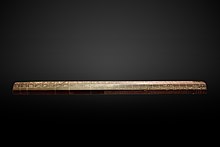
Back Codo (unidat) AN ذراع (وحدة قياس) Arabic Coldu (unidá) AST آرشین AZB Colze (unitat) Catalan Cubitu Corsican Cubit Danish Cubit (Einheit) German Πήχης (μονάδα μέτρησης) Greek Ulno (unuo) Esperanto


The cubit is an ancient unit of length based on the distance from the elbow to the tip of the middle finger.[1] It was primarily associated with the Sumerians, Egyptians, and Israelites. The term cubit is found in the Bible regarding Noah's Ark, the Ark of the Covenant, the Tabernacle, and Solomon's Temple. The common cubit was divided into 6 palms × 4 fingers = 24 digits.[2] Royal cubits added a palm for 7 palms × 4 fingers = 28 digits.[3] These lengths typically ranged from 44.4 to 52.92 cm (1 ft 5+1⁄2 in to 1 ft 8+13⁄16 in), with an ancient Roman cubit being as long as 120 cm (3 ft 11 in).
Cubits of various lengths were employed in many parts of the world in antiquity, during the Middle Ages and as recently as early modern times. The term is still used in hedgelaying, the length of the forearm being frequently used to determine the interval between stakes placed within the hedge.[4]
- ^ "Definition of CUBIT". 2 February 2024.
- ^ Vitruvian Man.
- ^ Stephen Skinner, Sacred Geometry – Deciphering The Code (Sterling, 2009) & many other sources.
- ^ Hart, Sarah. "The Green Man". Shropshire Hedgelaying. Oliver Liebscher. Archived from the original on 17 January 2019. Retrieved 18 May 2017.
On the roadside the finish is clean and neat, a living fence of intertwined branches between stakes placed an old cubit (the length of a man's forearm or approximately 18 inches) apart.
© MMXXIII Rich X Search. We shall prevail. All rights reserved. Rich X Search